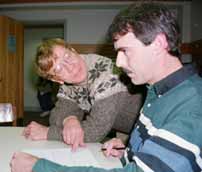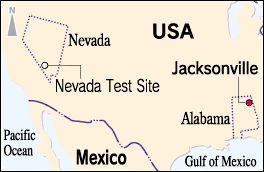Discounted Casualties:The Human Cost of Depleted Uranium, Part 1 <7> Educational video Suppressed – Military fears public reaction
Apr. 11, 2000
Protection test at Nevada Nuclear Test Site
Jacksonville State College in the heart of Jacksonville, a small city in Alabama. After providing guidance to a graduate student, Douglas Rokke (50), professor in the Department of Physical and Earth Sciences, returned to his research room. Taking a video off the book shelf, he said, "First, take a look at this."
Rokke worked for the army as a health physicist until three years ago. Since quitting, he retains his position as a major in the army reserves.
"I directed the project that produced this 15-minute video on protecting soldiers from being exposed to depleted uranium particles. The project took from 1994 to 1996."
Explaining protective measures on the battlefield
In the video, tanks hit by DU shells blazed in columns of fire. Soldiers approached wearing space-suit-like protective uniforms and masks. Incorporating footage from tests conducted at the Nevada nuclear testing site, the video used simple language to describe the characteristics of depleted uranium and explain how to handle it safely in actual warfare.
"Besides the video project, based on the results of the tests, we came up with and presented to the army a curriculum for training soldiers about DU, health exams, cleaning up contaminated tanks, and more. We did it all under orders from the top."
Rokke first encountered the problem of DU rounds immediately after the end of the Gulf War in 1991, when he was appointed officer in charge of the "special project team" to return tanks and armored vehicles destroyed by friendly fire by ship from Saudi Arabia to the US. In three months starting mid March, they brought back 24 vehicles. All the roughly 250 persons involved in this task absorbed tiny DU particles in their bodies.
"We had rudimentary knowledge about DU, but we didn't know the true danger. Our superiors said it was safe. With the temperature climbing over 100oF (about 38oC), we hardly even used our simple masks."
Danger clear after tests
Even while he was still in the Middle East, Rokke knew something was wrong with his breathing, but he assumed it was simply because the environment was so dusty. Only after tests began in 1994 did he come to understand the dangers of DU.
During the war, when DU rounds penetrated tanks, if the soldiers in them managed to survive the fire and explosions, they were enveloped in minute uranium particles forming thick clouds that blocked visibility even a meter away. Internal exposure was unavoidable. One shell can spray DU particles - invisible micro units 1/1000th of a millimeter-over a radius of almost 400 meters (about 437 yards). Contamination was reportedly especially severe within a 25-meter (about 27 yards) radius.
"On the battlefield, many DU rounds were used in close proximity, turning the whole area into a 'hot zone.'"
Rokke's group created this video and the other elements of their protective-measures training program based on actual tests. How are the videos being used now?
Whole curriculum classified
"The shame is that they're not being used at all. The army remade the video in 1998 and our entire curriculum is now classified material." The words came out in an angry rush.
In 1996, Rokke began demanding that the military implement an educational program. The following year, the military research center he directed was closed, and he lost his job.
Rokke believes that the military rejected his training materials because following his suggestions would be too demanding and costly.
"Of course it would be costly." He came to the point. "Beyond that, they're worried that it would foment 'unreasonable fears of DU among soldiers.' If international opposition grows, they might not be able to use these weapons any more."
(Originally published on April 11, 2000)









